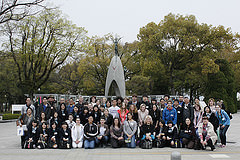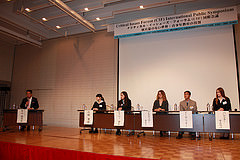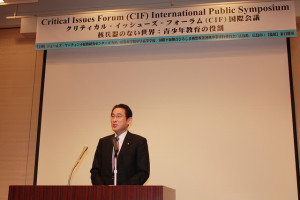
CIF participants in front of the Hiroshima Children’s Peace Monument
Critical Issues Forum (CIF)
From April 2-4, 2015, students from the United States and Russia joined Japanese students in Hiroshima, Japan, for the annual Critical Issues Forum (CIF) conference on nuclear disarmament. The James Martin Center for Nonproliferation Studies (CNS) at the Middlebury Institute of International Studies at Monterey (MIIS) cosponsored the conference as part of the CIF program, in partnership with Hiroshima Jogakuin Senior High School and the Hiroshima for Global Peace Plan Joint Project Executive Committee (Hiroshima Prefecture and Hiroshima City).
This was the first time in the eighteen-year history of the CIF that the student conference was held in Hiroshima—the first city to have ever experienced nuclear devastation—in commemoration of the seventieth anniversary of the 1945 atomic bombings of Hiroshima and Nagasaki.
The three-day conference included two days of students’ presentations at Hiroshima Jogakuin, where all the participating schools demonstrated their semester-long studies on this year’s topic, “Nuclear Disarmament: Humanitarian Approach.”
The last day of the conference featured speeches by Foreign Minister Fumio Kishida, Hiroshima Governor Hidehiko Yuzaki, as well as a keynote speech by Mr. Yoshitoshi Nakamura, the deputy director general in the Ministry of Foreign Affairs’ Disarmament, Non-Proliferation, and Science Department. The students also organized a showcase of their presentations from the previous day, and then held a panel discussion featuring students from each country, which was moderated by Professor Nobumasa Akiyama, one of Japan’s foremost nuclear disarmament and nonproliferation experts.
To further enhance their understanding of the horror of nuclear weapon use, teachers and students visited the Hiroshima Peace Memorial Museum and heard a first-hand account of August 6, 1945, from a hibakusha, an atomic bomb survivor.
All participants agreed that their CIF experience in Hiroshima was informative, enriching, and enlightening.
International High School Students’ Conference

CIF students from each country in the panel discussion at public symposium moderated by Professor Nobumasa Akiyama
On April 2 and 3, students presented their findings of their semester-long studies on this year’s topic, “Nuclear Disarmament: Humanitarian Approach.”
Following an opening statement by Masako Toki, CIF project manager, and welcoming remarks by Mr. Haruo Hoshino, the principal of Hiroshima Jogakuin Senior High School, the students watched a video message from Ms. Virginia Gamba, director and deputy to the high representative for disarmament affairs, United Nations Office for Disarmament Affairs. In her message, she congratulated participants for holding such an important conference to promote disarmament and nonproliferation education in Hiroshima, and she expressed her hope that students continue their work toward a nuclear-weapon-free world.
Given the topic of this year’s CIF project, many schools investigated the effects of nuclear weapon use on both the environment and human beings. Due to the deep concern about the catastrophic humanitarian consequences of any use of nuclear weapons, many students supported the idea to ban nuclear weapons based on their studies of these weapons from scientific, environmental, political and cultural perspectives. Many students’ presentations pointed out the shortcomings of the Treaty on the Non-Proliferation of Nuclear Weapons (NPT), such as its discriminatory nature and weak enforcement mechanism.
All the high school students’ presentations contained creative and innovative ideas while demonstrating a solid understanding on the topic they learned through their semester-long thorough research.
Student Presentation Highlights
In their presentation, students from Santa Catalina High School in Monterey, California, explored how to apply the humanitarian initiative while pursuing disarmament and maintaining a collaborative relationship with both nuclear weapon states and non-nuclear weapon states. Through their investigation, the Santa Catalina students proposed pursuing a change in the NPT, essentially transforming it into to a Nuclear Nonproliferation and Disarmament Treaty (NPDT).
The host school, Hiroshima Jogakuin, gave one of the most multidimensional presentations, incorporating a skit, music, and PowerPoint presentation to demonstrate their thoughts on the need to ban nuclear weapons. Hiroshima Jogakuin has a long history of peace and disarmament education, given their experience of losing over 300 students in the atomic bomb attack on August 6, 1945. Hiroshima Jogakuin’s presentation conveyed the horrific effects of the use of nuclear weapons against human beings, and emphasized the importance of raising awareness of this issue, asserting that the nuclear threat is everyone’s problem.
Pasadena High School from California formed a Nuclear Nonproliferation Club for the CIF project. The students argued that the NPT ultimately proved to be a “successful, failed experiment.” While it prevented a catastrophic nuclear war during the critical period of the Cold War, it failed to wholly prevent further nuclear proliferation or achieve a world without nuclear weapons.
A first time participant, Harker School from San Jose, California, presented a comparative analysis of the feasibility of achieving nuclear disarmament through an emphasis on humanitarian considerations. The students investigated several different successes in humanitarian-centered efforts, such as the abolition of slavery, the conclusion of the Chemical Weapons Convention, and the Landmine Ban Treaty (officially known as the Convention on the Prohibition of the Use, Stockpiling, Production and Transfer of Anti-Personnel Mines and on Their Destruction). The students formulated their presentation by analyzing how, based on these precedents, a similarly humanitarian-focused initiative on nuclear weapons could lead us to a more peaceful world without nuclear weapons.
Yokohama Senior High School of International Studies, Kanagawa, emphasized the importance of nuclear disarmament education, proposing standardized disarmament and nonproliferation education for the youth. The Yokohama students argued that effective disarmament education will eventually impact the nuclear policies of states, leading to more disarmament progress.
This year, two Russian schools participated in the conference. Both schools’ presentations were very creative and well-researched. Students from Novouralsk illustrated stories of the lives of children who became victims of nuclear weapons, effectively conveying the inhumane nature of such weapons. They highlighted the importance of achieving a world free of nuclear weapons for the future generation. Students from Zelenogorsk discussed the importance of international humanitarian law and the grassroots movement for nuclear disarmament.
For the entire program, please see the booklet. The presentations will be also posted on the CIF website.
Guest speakers
Mr. Steven Leeper, former chair of the Hiroshima Peace Culture Foundation, gave a keynote address titled “Youth, Education and a Nuclear-Weapon-Free World.” He emphasized the importance of the culture-of-peace approach to accomplish nuclear abolition, an effort he believes warrants a high sense of urgency, as well as the necessary resources to accomplish it.
Mr. Jeffrey Adler from the US Embassy in Tokyo gave a presentation on the importance of the US-Japan cooperation for nuclear nonproliferation. In his talk, “Strength of People to People Relationships,” he highlighted the educational and cultural activities for a better relationship between the two countries, which he says contributes to peace and security in the Asia Pacific region as well as the entire world.
Public Symposium

Foreign Minister Fumio Kishida congratulates CIF participants
The three-day CIF conference culminated with the public symposium at the Hiroshima International Conference Center. The CIF attracted the highest ranking official of the Japanese government, Minister of Foreign Affairs Fumio Kishida, who is originally from Hiroshima. In his speech at the symposium, the foreign minister congratulated CNS and the co-organizers in holding this important event in Hiroshima with students from the United States, Russia, and Japan, and highlighted the importance of disarmament education for the next generations. He also discussed Japan’s role in building a world without nuclear weapons, elaborating on his country’s role in the upcoming NPT Review Conference as well as the twelve-nation Nonproliferation and Disarmament Initiative (NPDI) that Japan co-founded with Australia.
Hiroshima Governor Hidehiko Yuzaki congratulated and thanked all CIF participants and organizers. In his speech, the governor illustrated Hiroshima’s recent efforts toward a world free of nuclear weapons, such as publishing the Hiroshima Report and hosting the Hiroshima Round Table. He also noted that he will be participating in the upcoming NPT Review Conference in order to underscore the importance of nuclear disarmament.
Ambassador Yasuyoshi Komizo, chair of the Hiroshima Peace Culture Foundation, expressed his hope that the international community starts negotiating a nuclear weapon convention to delegitimize these weapons, given the catastrophic effects of the use of nuclear weapons.
Students from Choate Rosemary Hall in Connecticut and Kaisei High School in Tokyo made a joint presentation showcasing their studies on the humanitarian approach to nuclear disarmament and their experiences in the CIF project. The two schools combined the presentations they had presented at the Hiroshima Jogakuin on previous day.
Both schools challenged the current NPT regime by investigating why a world free of nuclear weapons has not been achieved through the NPT. The students also addressed the legality of the use of nuclear weapons, citing the 1996 advisory opinion on nuclear weapons by the International Court of Justice. The students further argued that there are many other ways that the money currently allotted toward nuclear weapons can be used in ways to more sustainably build peace, such as peacekeeping operations. In their concluding remarks, they emphasized that their presentation included only a few of the many great ideas that were presented at the conference. On behalf of all the CIF students, they implored the audience to raise awareness of these nuclear weapon issues, and to think seriously about what we can do to help advance nuclear disarmament.
The keynote address was given by Mr. Yoshitoshi Nakamura, the deputy director general in the Ministry of Foreign Affairs’ Disarmament, Non-Proliferation and Science Department. He presented an overview of Japan’s nuclear disarmament and nonproliferation policy, and the role of disarmament and nonproliferation education. He emphasized the importance of youth education as well as local community efforts to promote disarmament and nonproliferation education.
One highlight of the symposium was a panel discussion by students from each country, moderated by Professor Nobumasa Akiyama of Hitotsubashi University, a leading Japanese expert in nuclear nonproliferation and disarmament. Each student shared his or her own personal experience with nuclear disarmament initiatives and disarmament education.
As a third generation hibakusha, Ms. Masaki Koyanagi, a student from Kwassui High School in Nagasaki, expressed her determination to convey the catastrophic effects of nuclear weapons that her grandparents experienced. She affirmed her belief in the power of youth to make a positive impact on nuclear disarmament progress.
In her speech, student Amadea Tanner of Pasadena High School insisted that the key to overcoming obstacles to nuclear disarmament is to “trust.” She said countries in possession of nuclear weapons do not trust each other to take steps toward getting rid of their weapons, but she believes that trust can be restored one step at a time.
Her statement resonated with many of audience. She also articulated her determination to educate as many people as possible on nuclear disarmament issues. Ethan Ma from Harker School argued that the movement to end nuclear weapons must be a step within the greater movement toward peace.
Yuina Capper from Hiroshima Jogakuin asserted that the biggest obstacle to abolish nuclear weapons is the people who think it is safer to have nuclear weapons. Therefore, she is convinced that it is important for her to show those people how nuclear weapons can destroy our lives and environment, and that in this way she can contribute to a creating a world free of nuclear weapons.
Valeria Serkova discussed how growing up in Zerenogorsk, Russia—a “closed city” established specifically to operate nuclear facilities—led her to be interested in nuclear disarmament. She emphasized the importance of taking action to make progress toward a nuclear-weapon-free world. Based on her experience in disarmament and peace activities at her school, she argued that education provides young people with the necessary, solid foundation to work for nuclear disarmament.
These future leaders in nuclear disarmament stimulated other students in the audience, and there were many constructive questions. Professor Akiyama concluded the symposium by encouraging all the participating students to further their interest in this vital global issue and to all strive to become leaders in this field.
Throughout the three-day conference, there was significant media coverage. The public symposium, in particular, was broadcast nationwide by NHK, Japan’s national TV station. Almost 200 people gathered for the public symposium in the 150-capacity room, illustrating the significant public interest in nuclear disarmament discussions by high school students from the United States, Russia, and Japan.
Conclusion
As the main organizer of the CIF project, CNS worked very hard with the co-organizers—Hiroshima Jogakuin, Hiroshima prefecture, Hiroshima city, and all the participating schools. This conference was a historic achievement in disarmament and nonproliferation education, not only because the foreign minister participated, or that it happened in Hiroshima to commemorate the 70th anniversary, but also that these high school students worked so hard to think critically about this complicated issue, in order to find their own, innovative solutions. Through the CIF activities, all the students were able to develop their critical-thinking skills, and learned nuclear nonproliferation and disarmament issues, the impact of the use of nuclear weapons, and examined challenges to creating a world free of nuclear weapons. Most importantly, many of these students realized that they are the ones who are responsible for achieving that goal.
In that sense, the power and promise of education toward this end needs to be more widely recognized by more people around the world. The United Nations Secretary-General Ban Ki-moon, in his monumental speech on disarmament at MIIS two years ago, eloquently stated that “Education can also help to refute the claim that nuclear disarmament is utopian … Education can help the world to build a global culture of peace that rejects all weapons of mass destruction as illegitimate and immoral.” CNS hopes that this type of educational project will give more opportunities to many young students to further raise their awareness of these global challenges, strengthen their determination to work toward this goal, and start something they can do, no matter how small it may seem.
For more information about the CIF project, visit the CIF website.
The full photo gallery is available on Flickr.
Participating Schools
United States
Choate Rosemary Hall, Wallingford, CT
Cushing Academy, Ashburnham, MA
Harker School, San Jose, CA
Pasadena High School, Pasadena, CA
Presque Isle High School, Presque Isle, ME
Rock University High School, Janesville, WI
Santa Catalina School, Monterey, CA
Japan
Hiroshima Jogakuin Senior High School, Hiroshima
Kwassui High School, Nagasaki
Yasuda Girls High School, Hiroshima
Yokohama Senior High School of International Studies, Kanagawa
Kaisei High School, Tokyo
Russia
Gymnasium No 41, Novouralsk
Gymnasia No 164, Zelenogorsk
